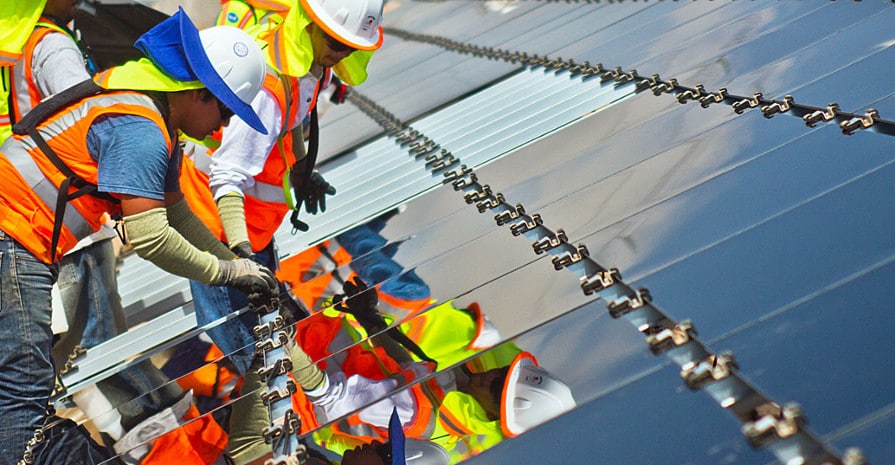As renewable energy auctions continued to achieve record low prices at or around $30/MWh in Chile, Mexico, Morocco, the UAE and the U.S., the investment flow in the global energy arena has shifted away from nuclear power, resulting in only three nuclear reactors starting construction in 2016.
Global nuclear power generation went up by 1.4% in 2016, due to a 23% increase in China, although the share of nuclear energy in electricity generation stagnated at 10.5% (–0.2%), reads the World Nuclear Industry Status Report (WNISR) in an overview of the nuclear power plant data.
Nuclear hotspots
In terms of worldwide nuclear deployment, the report identifies the “big five” generating countries by rank – the U.S., France, China, Russia, and South Korea – which generated 70% of the world’s nuclear electricity in 2016. And while the U.S. and France accounted for 48% of global nuclear generation, China moved up one place in the rankings.
Painting the picture of nuclear’s lackluster performance in 2016, the report shows that the number of new projects worldwide has dropped to a decade low in the wake of the 2011 Fukushima disaster and also due to the rising costs of atomic energy, with only three new plants breaking ground in 2016: two in China and one in Pakistan (built by a Chinese company), totaling 3 GW capacity.
From a high of 15 in 2010, the number of construction starts of nuclear reactors worldwide dropped to 10 in 2013, eight in 2015, three in 2016, and just one in India in the first half of 2017, show the WNISR findings. Meanwhile, playing the leading role in the worldwide nuclear deployment, China has slowed down its hectic activity from 10 in 2010 to six in 2015 and just two construction starts last year.
Ten reactors started up in 2016, of which one-half were in China. Two reactors were connected to the grid in the first half of 2017—one in China, one in Pakistan (by a Chinese company)—the first units to start up in the world whose construction started after the Fukushima disaster began, reads the report.
Closures, construction delays, financial turmoils
Providing extensive information on operation, production and construction, the reports notes that Russia and the U.S. shut down reactors in 2016, while Sweden and South Korea both closed their oldest units in the first half of 2017, adding that the change of political leadership, such as the one in South Korea, where the new president has already closed one plant and suspended the construction of two more, may bring sweeping changes for the nuclear sector.
Thirteen countries are building new reactors, which is one less than in 2015, the report finds, showing that there are 37 reactor constructions behind schedule, of which 19 reported further delays over the past year. In China alone, out of 20 units under construction, 11 are behind schedule.
The (renewables) game is on
Citing the findings of the REN21 report released earlier this year, WNISR notes that a total of 161 GW of renewable capacity was added in 2016, which is the largest increase ever, with a record growth of solar PV reaching 75 GW, compared to 9 GW for nuclear.
The groundbreaking record-low prices for renewables are expected to diminish the share of nuclear even further in the coming years, the report finds, adding that for solar, a learning curve is estimated at up to 24.3% per doubling of cumulative production, with real prices plummeting by 90% since 2009 alone.
Noting that the investment decisions remain an important indicator of the future power mix, the report reads that following an all-time high of over $310 billion in 2015, global investment in new renewable energy-based electricity generating capacity dropped to about $240 billion.
However, WNISR2017 underlines that the 23% fall in investment volume mainly reflects the rapid reduction in cost per GW, as renewable generation is much cheaper than new nuclear power plants globally and is competing with the cheapest conventional generation technologies in an increasing number of countries.
This content is protected by copyright and may not be reused. If you want to cooperate with us and would like to reuse some of our content, please contact: editors@pv-magazine.com.









By submitting this form you agree to pv magazine using your data for the purposes of publishing your comment.
Your personal data will only be disclosed or otherwise transmitted to third parties for the purposes of spam filtering or if this is necessary for technical maintenance of the website. Any other transfer to third parties will not take place unless this is justified on the basis of applicable data protection regulations or if pv magazine is legally obliged to do so.
You may revoke this consent at any time with effect for the future, in which case your personal data will be deleted immediately. Otherwise, your data will be deleted if pv magazine has processed your request or the purpose of data storage is fulfilled.
Further information on data privacy can be found in our Data Protection Policy.